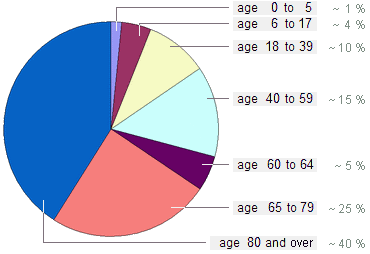The Braille Alphabet
That well-known dot-writing system was invented

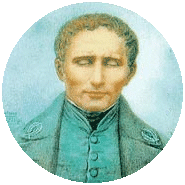
Text will be read with the touch sense of fingers. The characters
Louis Braille, blind since the age of 3, experimented for a long time until he found the solution:
 6 dots
6 dots
could be felt by one finger and yet available in different

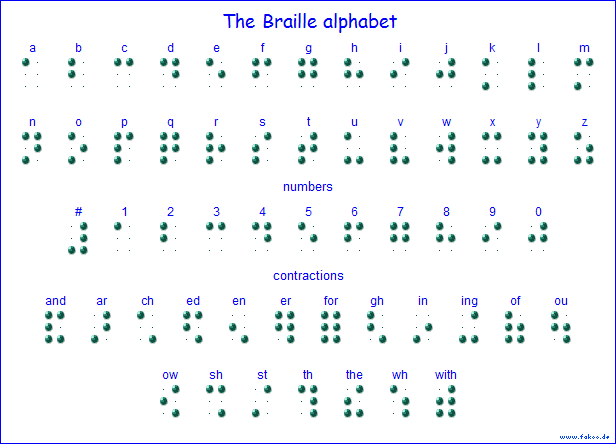
The english Braille alphabet:
---------- code table for english Braille (Braille code): ----------
number behind the 'd' are occupied dots,
the dots are numbered as follows:
Line 1 [1] and [4]
Line 2 [2] and [5]
Line 3 [3] and [6]
Braille character a = d 1
Braille character b = d 12
Braille character c = d 14
Braille character d = d 145
Braille character e = d 15
Braille character f = d 124
Braille character g = d 1245
Braille character h = d 125
Braille character i = d 24
Braille character j = d 245
Braille character k = d 13
Braille character l = d 123
Braille character m = d 134
Braille character n = d 1345
Braille character o = d 135
Braille character p = d 1234
Braille character q = d 12345
Braille character r = d 1235
Braille character s = d 234
Braille character t = d 2345
Braille character u = d 136
Braille character v = d 1236
Braille character w = d 2456
Braille character x = d 1346
Braille character y = d 13456
Braille character z = d 1356
Braille character # = d 3456 [number sign]
Braille character 1 = d 1 [corresponds to letter a ]
Braille character 2 = d 12 [corresponds to letter b ]
Braille character 3 = d 14 [corresponds to letter c ]
Braille character 4 = d 145 [corresponds to letter d ]
Braille character 5 = d 15 [corresponds to letter e ]
Braille character 6 = d 124 [corresponds to letter f ]
Braille character 7 = d 1245 [corresponds to letter g ]
Braille character 8 = d 125 [corresponds to letter h ]
Braille character 9 = d 24 [corresponds to letter i ]
Braille character 0 = d 245 [corresponds to letter j ]
Braille character . = d 256
Braille character , = d 2
Braille character : = d 25
Braille character ; = d 23
Braille character - = d 36
Braille character ( = d 2356 [corresponds to ) ]
Braille character ) = d 2356 [corresponds to ( ]
Braille character ! = d 235
Braille character ? = d 236 [corresponds to „ ]
Braille character & = d 12346
Braille character ' = d 3
Braille character “ = d 236 [open quote, corresponds to '?' ]
Braille character ” = d 356 [close quote]
Braille character ´ = d 4
------------- End Braille code ---------------
[to the top]
|
Displays various versions of the Braille Alphabet for printing
the french Braille alphabet
 for comparison
for comparison
TTF fonts:

Here you can download various Braille fonts.
On the page
 Braille learning you can learn the Braille writing system.
Braille learning you can learn the Braille writing system.
You can find examples in Braille on
 Braille exercises (sample texts).
Braille exercises (sample texts).
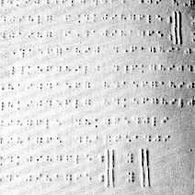 |
Louis Braille

On the left (before) you see a music score, 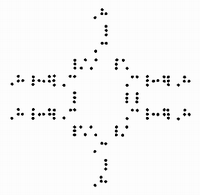
|
 |
Due to the development in the year 1825 is clear:
The basics of Braille for the written communication of the blind:

- The basic sign (full cell) consists of 6 dots and is sometimes used for orientation.
The dots are numbered according to the following schedule:

top line [1] and [4] 

middle line [2] and [5] 

bottom line [3] and [6] - The number of possible characters amounts to
2 to the power of 6 = 64, without blanks thus 63. Not all combinations of dots are useful standing alone, because the dot writing is read with the fingers in contrast to print. The basic pattern of the Braille letters "a" to "j" is modified for the remaining letters and characters at the dot locations [ 3 ], [ 3 and 6 ] or [ 6 ]. Afterwards the remaining combinations follow. 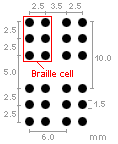 A Braille character with its maximum of six or eight dots is called a cell.
A Braille character with its maximum of six or eight dots is called a cell.
The size of touchable Braille characters is 6 to 7 mm, and customarily have the following dimensions:
 Dot-spacing 2.5 mm
Dot-spacing 2.5 mm
 Dot-thickness 1.5 mm (diameter)
Dot-thickness 1.5 mm (diameter)
 Cell spacing 6 mm
Cell spacing 6 mm
 Line spacing 10 mm
Line spacing 10 mm
 Height (survey) at least 0.4 mm
Height (survey) at least 0.4 mm
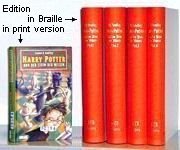
Due to the tactile minimum size of the signs and the need to use thicker paper, documents and books are much larger and heavier than comparable editions in print.For the blind, the term print is used to describe the font for the sighted. Often, the term 'normal type' is using for print, as opposed to Braille. - There are only lowercase letters in Braille. If an uppercase letter must be designated, then 'CAP' (D6 )' is
written in front. 'CAP' written twice (D6 D6 ) designates a word which only
exists in uppercase letters.
[ correct uppercase letters only exist in the Braille alphabet system using 8 dots (Computer Braille) ] - For the display of numbers, the letter "a" to "j" is used. Numbers are started with the number-sign '#' (D3456 ) and end with the space or with letter-sign 'LTR' (D56 ) if a letter "a" to "j" follows.
- Some dot-combinations have several meanings, depending on the context of use. The three charcters 'S1' (D5 ), 'S2' (D456 ) and 'S3' (D45 ) change the meanings of the following letters by using contractions.
- If Braille is written by hand, the dots are pressed backward into the paper with the aid of a stencil (dot writing slate) and a pen (stylus). For reading, the paper is taken out and turned around. If a Braille writer (machine) is used, the turning around step can be skipped. 6 or 8 keys are used to write (7 or 9 keys with spacebar). You can write on your own computer using 6 keys of Braille on the Braille slate simulator or the Braille writing simulator:
 all digital clocks of fakoo.de
all digital clocks of fakoo.de
Statistical Values:
- Among the blind, only about 20% have knowledge of Braille writing.
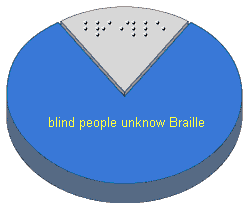
The classification of blind by age shows that most blind people are over 60 years old. These people are often unable to learn the complexities of Braille and therefore are satisfied with acoustic alternatives.These numbers are extrapolations from Germany, as exact figures are not available. Due to rising life expectancy and the associated "aging society", we can figure that the percentage of blind people in society will be increasing.